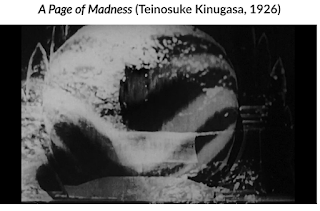International Style 1920s
Stylistic influences also circulated among countries. French Impressionism, German Expressionism, and Soviet Montage began as largely national trends, but soon the filmmakers exploring these styles became aware of each other’s work. By the mid-1920s, an international avant-garde style blended traits of all three movements.
The Blending of Stylistic Traits
Caligari’s success in France in 1922 led French directors to add Expressionist touches to their work. In 1928, Jean Epstein combined Impressionist camera techniques with Expressionist set design to create an eerie, portentous tone in The Fall of the House of Usher, based on Edgar Allan Poe’s story. A corner in a room of Usher’s mansion in Epstein’s adapation displays the influence of German Expressionism.
The Fall of the House of Usher (Jean Epstein, 1928)
Books are tumbling from behind the curtain
Wind is blowing into the room from behind the curtains
The guest is scared the old guy tells him not to worry
guy starts playing the guitar
At the same time, French Impressionist traits of subjective camera devices were cropping up in German films. Karl Grune’s The Street, an early example of the street film, used multiple superimpositions to show the protagonist’s visions. The Last Laugh and Variety popularized subjective cinematographic effects that had originated in France. By the mid-1920s, the boundaries between the French Impressionist and German Expressionist movements were blurred. In The Street, Impressionist-style superimpositions depict the hero’s visions of delights that await him in the city.
The Street (Karl Grune, 1923)
The Montage movement started somewhat later, but imported films soon allowed Soviet directors to pick up on European stylistic trends. The rapid rhythmic editing pioneered by Epstein and Abel Gance in 1923 was pushed further by Soviet filmmakers after 1926. Grigori Kozintsev and Leonid Trauberg’s 1926 adaptation of Gogol’s The Cloak contained exaggerations in the acting and mise-en-scène that were reminiscent of Expressionist films. The Cloak contains grotesque elements that recall German Expressionism, such as this giant steaming teapot that heralds the beginning of a strange dream sequence.
The Cloak (Grigori Kozintsev and Leonid Trauberg, 1926)
In turn, from 1926 onward, Soviet Montage films wielded influence abroad. Leftist filmmakers in Germany embraced the Soviet style to make politically charged cinema. A shot from the final march scene in Mutter Krausens Fahrt ins Glück (“Mother Krausen’s Journey to Happiness,” 1929, Piel Jutzi) echoes the climactic demonstration scene in Pudovkin’s Mother. A low angle isolates the major characters against the sky in Soviet Montage fashion as they march in protest.
Mutter Krausens Fahrt ins Glück (Piel Jutzi, 1929)
French, German, and Soviet techniques had an impact in many countries. Two of the most notable English directors of the 1920s reflected the influence of French Impressionism. Anthony Asquith’s second feature, Underground (1928), used a freely moving camera and several subjective superimpositions to tell a story of love and jealousy in a working-class milieu. As the heroine of Underground looks up at a building, a superimposition reminiscent of French Impressionism conveys her vision of the villain.
Underground (Anthony Asquith, 1928)
Alfred Hitchcock’s boxing picture, The Ring (1927), demonstrated his absorption of Impressionist techniques in its many subjective passages. Hitchcock also acknowledged his debts to German Expressionism, an influence evident in The Lodger (1926). For decades, he would draw on avant-garde techniques he learned in the 1920s. In The Ring, Hitchcock uses distorting mirrors in this shot of dancers to suggest the hero’s mental turmoil during a party.
The Ring (Alfred Hitchcock, 1927)
nice cut-in
Two men talking: it's understood you start training to-morrow.
It's not necessary for you to take your wife with you, she can stay here.
Here's the distorted mirror shot below
cool shot
triple imposition

The international influence of the commercial avant-garde reached as far as Japan. By the 1920s, Japan was absorbing European modernism in its arts, primarily literature and painting. Futurism, Expressionism, Dada, and Surrealism were all welcomed. One young filmmaker, Teinosuke Kinugasa, was already well established in commercial production, having made over thirty low-budget pictures. He was also associated with modernist writers in Tokyo. In 1926 with their help, he independently produced a bizarre film. A Page of Madness carried Expressionist and Impressionist techniques to new extremes. Taking a cue from Caligari, Kinugasa set the action in a madhouse, with distorting camera devices and Expressionist mise-en-scène frequently reflecting the deranged visions of the inmates. The plot that motivates these strange scenes is full of flashbacks and fantasy passages. Kinugasa’s next film, Crossroads (1928), was less difficult but still reflected influences from European avant-garde films. It was the first Japanese feature to receive a significant release in Europe. In the following enigmatic scene from A Page of Madness, an inmate obsessed with dancing appears in an elaborate costume, performing in an Expressionist set containing a whirling, striped ball.
A Page of Madness (Teinosuke Kinugasa, 1926)It's raining severely
running water (kind of montage style)
rain and water flowing again
water imposed over window
shoes and trench coat in water
lots of shots of rain and the window
total montage going back and forth between all these images
The speed has quickened to a few seconds each
now this?
three superimpositions
Here's the shot of the Expressionist set
She keeps dancing and dancing
Then this cool shot
Wow, then this






















































No comments:
Post a Comment